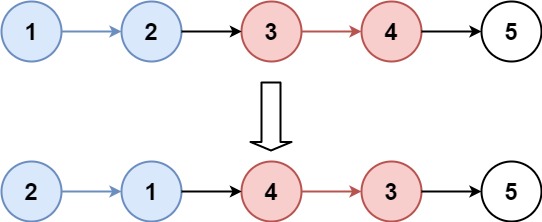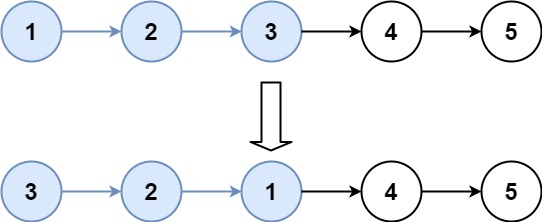25. Reverse Nodes in k-Group | Leetcode Solution
Given the head of a linked list, reverse the nodes of the list k at a time, and return the modified list.
k is a positive integer and is less than or equal to the length of the linked list. If the number of nodes is not a multiple of k then left-out nodes, in the end, should remain as it is.
You may not alter the values in the list's nodes, only nodes themselves may be changed.
Example 1:

Input: head = [1,2,3,4,5], k = 2
Output: [2,1,4,3,5]
Example 2:

Input: head = [1,2,3,4,5], k = 3
Output: [3,2,1,4,5]
Constraints:
- The number of nodes in the list is
n. 1 <= k <= n <= 50000 <= Node.val <= 1000
Solution :
/**
* Definition for singly-linked list.
* struct ListNode {
* int val;
* ListNode *next;
* ListNode() : val(0), next(nullptr) {}
* ListNode(int x) : val(x), next(nullptr) {}
* ListNode(int x, ListNode *next) : val(x), next(next) {}
* };
*/
class Solution {
public:
ListNode* solve(ListNode* head, int k , int cnt)
{
if(cnt < k )
{
return head;
}
if(head == NULL )
{
return head;
}
int t =0;
ListNode* curr = head;
ListNode* pre = NULL ;
ListNode* nex = NULL;
ListNode* x =NULL;
while(cnt >= k && t < k )
{
if(t == 0)
{
x = curr;
}
nex = curr ->next;
curr ->next = pre;
pre = curr;
curr = nex;
t++;
}
x ->next = solve(curr , k, cnt - k);
return pre;
}
ListNode* reverseKGroup(ListNode* head, int k) {
ListNode* temp = head;
int cnt = 0;
while(temp != NULL)
{
cnt++;
temp = temp->next;
}
return solve(head , k , cnt);
}
}; |


Comments
Post a Comment